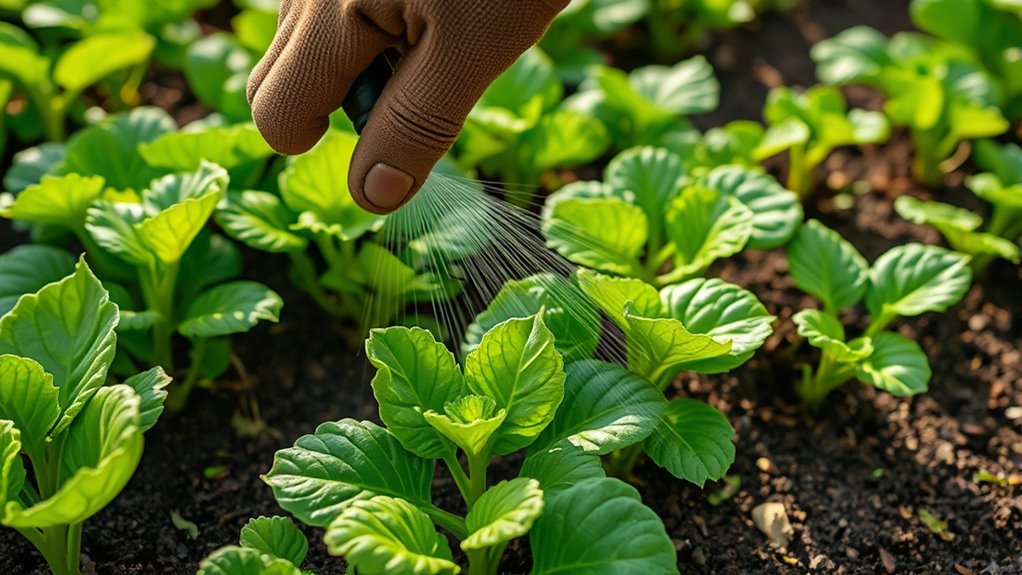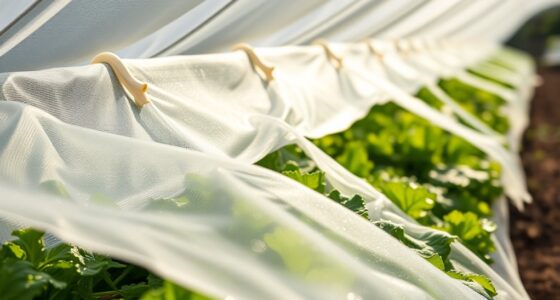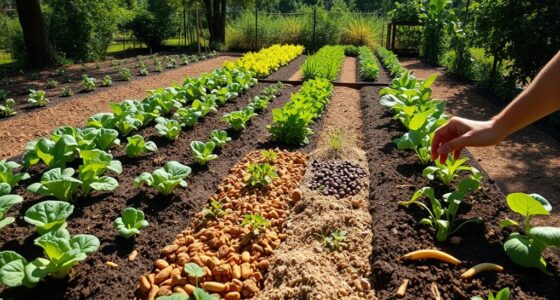Water early in the day to allow leaves and soil to dry before evening, reducing fungal chances. Use drip irrigation or soaker hoses to deliver water directly to roots, avoiding overhead watering that leaves foliage wet. Keep soil well-drained and mulch around plants to prevent moisture buildup. Water deeply but less often to encourage deep roots, and control humidity and airflow in growing areas. Continuing will help you master all practices to keep your plants healthier.
Key Takeaways
- Water early in the day to allow leaves and soil to dry before evening, minimizing prolonged moisture that fosters fungi.
- Use drip irrigation or soaker hoses to deliver water directly to roots, avoiding wet foliage.
- Maintain proper soil drainage and apply mulch to prevent soil compaction and retain moisture without oversaturating.
- Water deeply and infrequently to promote healthy root growth and reduce surface moisture.
- Ensure good airflow and control humidity levels to keep foliage dry and inhibit fungal development.
Water Early in the Day to Allow for Drying
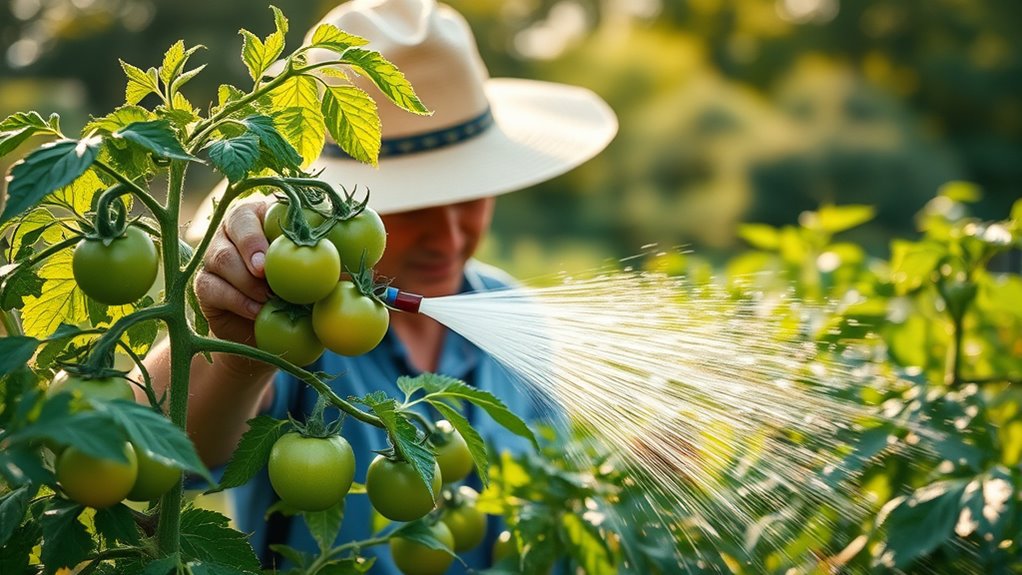
Water your plants early in the day so they have enough time to dry before evening. This timing optimization is vital for preventing fungal diseases caused by prolonged moisture. Morning watering allows leaves and soil to dry naturally, reducing the chances of mold and mildew growth. By scheduling your watering session during the cooler morning hours, you give plants a chance to absorb water without staying wet overnight. This practice promotes healthier roots and stronger growth. Remember, consistent morning watering not only helps avoid disease but also improves water efficiency. Avoid watering late in the afternoon or evening, as moisture left on plants overnight creates an ideal environment for fungi. Prioritize morning watering to keep your garden healthy and vibrant. Additionally, proper air circulation around your plants can further reduce humidity and help prevent fungal issues.
Use Drip Irrigation or Soaker Hoses
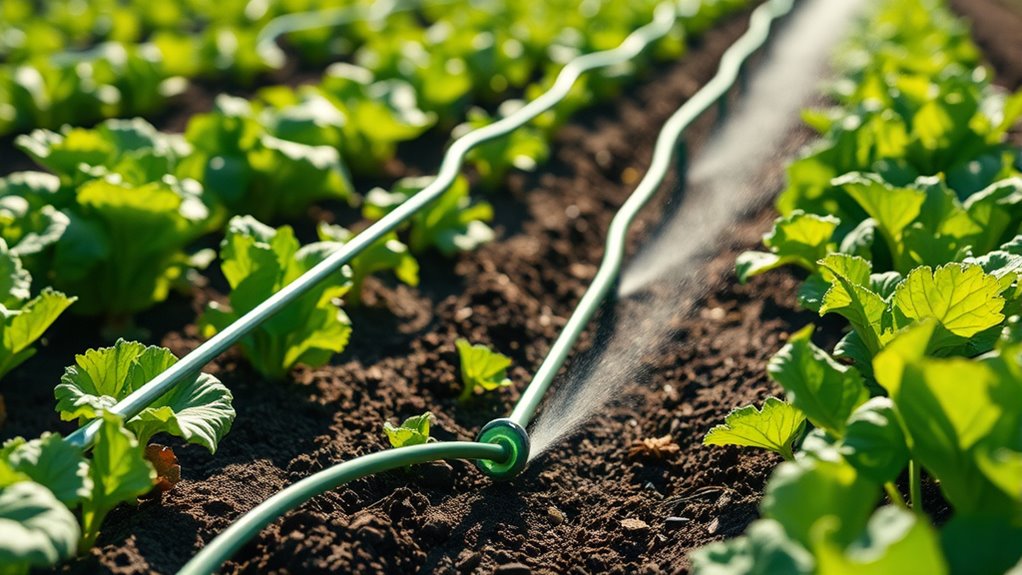
Using drip irrigation or soaker hoses offers an efficient way to deliver consistent moisture directly to your plants’ roots, minimizing water waste and reducing the risk of disease. Drip irrigation systems release water slowly and precisely, preventing excess moisture on foliage that can promote fungal growth. Soaker hoses, laid along plant rows or beds, evenly distribute water while keeping leaves dry. These methods ensure your plants receive the right amount of moisture without overwatering, which can create a damp environment ideal for fungi. They also save water by targeting roots directly, avoiding runoff and evaporation. Additionally, proper installation of these systems ensures optimal water distribution and minimal fungal risk. Implementing drip irrigation or soaker hoses helps maintain healthy, dry foliage and soil conditions, essential for preventing fungal diseases and promoting vigorous plant growth.
Water at the Base of Plants, Not Overhead
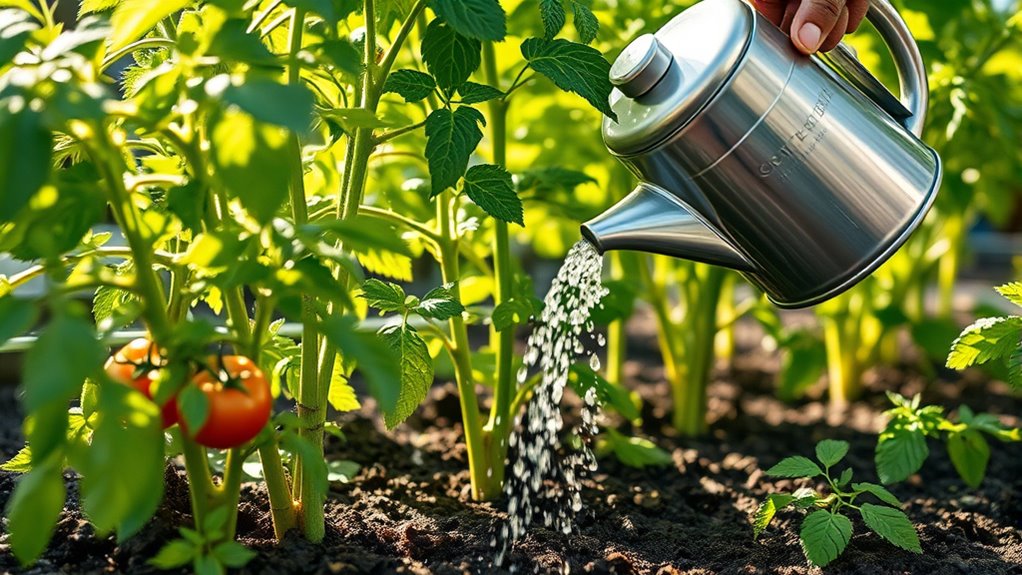
To prevent fungal diseases and promote healthy plant growth, it’s best to water at the base of your plants rather than overhead. Using methods like drip watering or ground level irrigation directs moisture where it’s needed most, reducing leaf wetness that fosters fungi. This approach keeps foliage dry and minimizes disease risk. Incorporating proper watering techniques can further improve plant health and reduce the likelihood of fungal infections.
Water at the base to keep foliage dry and prevent fungal diseases.
Consider these tips:
- Use drip watering systems to deliver water directly to the soil.
- Opt for ground level irrigation to avoid splashing water onto leaves.
- Water early in the day so excess moisture dries quickly.
Avoid Overwatering and Maintain Proper Soil Moisture

To keep your plants healthy, you need to maintain consistent soil moisture without overwatering. Water early in the morning so the soil can absorb it effectively and dry out during the day. Make sure your garden has proper drainage to prevent water from pooling and causing root problems. Additionally, monitoring soil moisture levels can help you adjust watering schedules to avoid overwatering and promote optimal plant growth.
Consistent Moisture Levels
Maintaining consistent soil moisture is essential for healthy plant growth, but overwatering can be just as harmful as underwatering. Fluctuating soil moisture levels create stress, increasing fungal disease risk. To keep soil moisture steady, follow a reliable watering schedule and monitor soil regularly. Here are some key tips:
- Water deeply and less frequently to promote strong roots.
- Use a moisture meter or touch the soil to check moisture levels.
- Adjust your watering schedule based on weather and soil conditions.
Consistency prevents overly wet or dry conditions that weaken plants. Proper soil moisture supports healthy growth and reduces fungal infections. By staying attentive to your watering schedule and soil moisture levels, you help maintain a healthier, more resilient garden.
Water Early Morning
Why is watering early in the morning considered the best time for your garden? Early watering promotes timing consistency, giving your plants enough moisture to thrive without staying wet all day. It also helps reduce water loss through evaporation, supporting water conservation. When you water in the morning, the soil absorbs moisture effectively, preventing overwatering and soggy conditions that promote fungal diseases. Consistent moisture levels are easier to maintain when you stick to a morning schedule, ensuring your plants get just what they need without excess. Avoid watering late in the day, which can leave foliage damp overnight, increasing disease risk. By watering early, you give your garden a healthy start, reduce waste, and create an environment less conducive to fungal problems.
Use Proper Drainage
Using proper drainage is essential to prevent overwatering and keep your soil at the right moisture level. Good drainage ensures excess water flows away, reducing the risk of fungal diseases. To improve drainage, consider these tips:
- Improve soil aeration by mixing in organic matter like compost or sand.
- Avoid compacting soil, which restricts water movement.
- Use raised beds or install drainage systems if your yard retains water.
These steps promote proper drainage, helping roots access oxygen and preventing water from pooling. Maintaining soil aeration allows moisture levels to stay balanced, reducing fungal growth. Regularly check your soil’s drainage capacity, especially after heavy rains, to ensure it remains effective. Proper drainage isn’t just about water flow; it’s about creating a healthy environment that discourages fungal diseases.
Improve Soil Drainage and Mulching Techniques
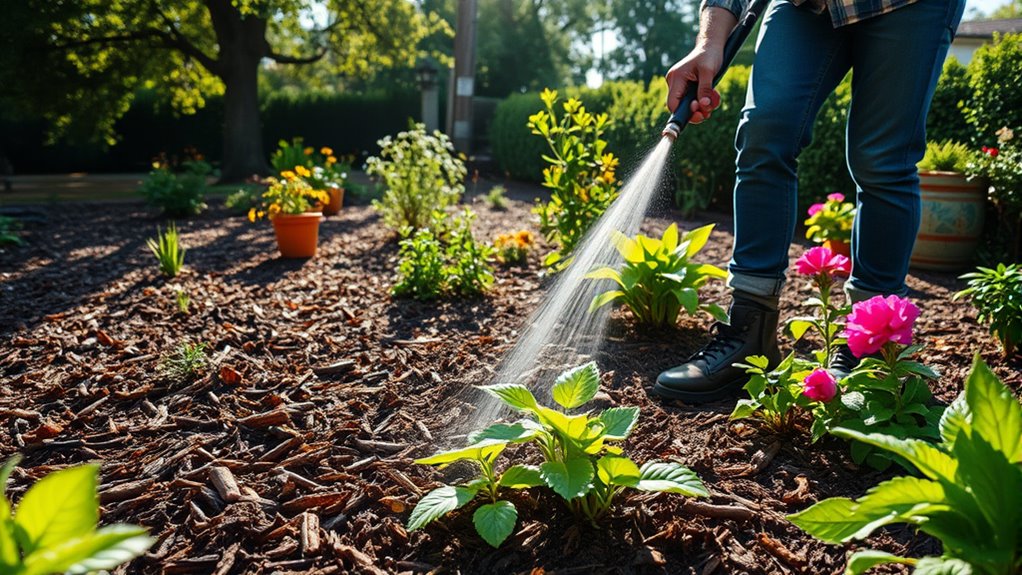
To improve soil drainage, focus on enhancing its structure by mixing in organic matter like compost. Applying a layer of organic mulch helps retain moisture while preventing soil compaction. These techniques work together to create healthier roots and better water management in your garden. Additionally, implementing consistent routines for watering can help prevent overwatering and reduce the risk of fungal disease.
Enhance Soil Structure
Improving soil structure is essential for healthy plant growth, and it can be achieved by enhancing drainage and applying effective mulching techniques. Good soil aeration allows roots to access oxygen, promoting overall plant health. Incorporating organic matter improves soil fertility and helps retain moisture while preventing compaction. To enhance soil structure, consider these steps:
- Loosen soil regularly to increase aeration and prevent compaction.
- Mix in compost or other organic matter to boost drainage and fertility.
- Use appropriate mulching techniques to maintain consistent moisture levels and protect against soil erosion.
Additionally, understanding how positive thinking can influence your gardening practices can foster a more resilient and proactive approach to plant care.
Apply Organic Mulch
Applying organic mulch is an effective way to enhance soil drainage and protect your garden from erosion. Organic mulch improves soil insulation, helping maintain consistent moisture levels and preventing rapid water runoff. When you spread a layer of mulch around your plants, it creates a barrier that reduces soil compaction and promotes better water absorption. This not only keeps the soil aerated but also minimizes excess moisture that can lead to fungal issues. Be sure to apply a 2-3 inch thick layer, avoiding direct contact with plant stems to prevent rot. Organic mulch such as straw, wood chips, or composted leaves enriches the soil as it decomposes, supporting healthy root growth and reducing the risk of fungal diseases caused by overly wet or poorly drained soil. Additionally, regular assessment and rotation of mulch helps prevent the buildup of mold and pests that could contribute to fungal problems.
Water Less Frequently but Deeply

Water less often but make each watering session thorough enough to reach the root zone. Deep watering encourages roots to grow downward, improving moisture retention and plant stability. When you water deeply, you reduce the frequency needed, which helps prevent excess moisture on the surface that fosters fungal diseases. Incorporating inspirational quotes about nurturing and patience can motivate consistent and mindful watering practices.
Monitor Humidity and Ventilation in Growing Areas
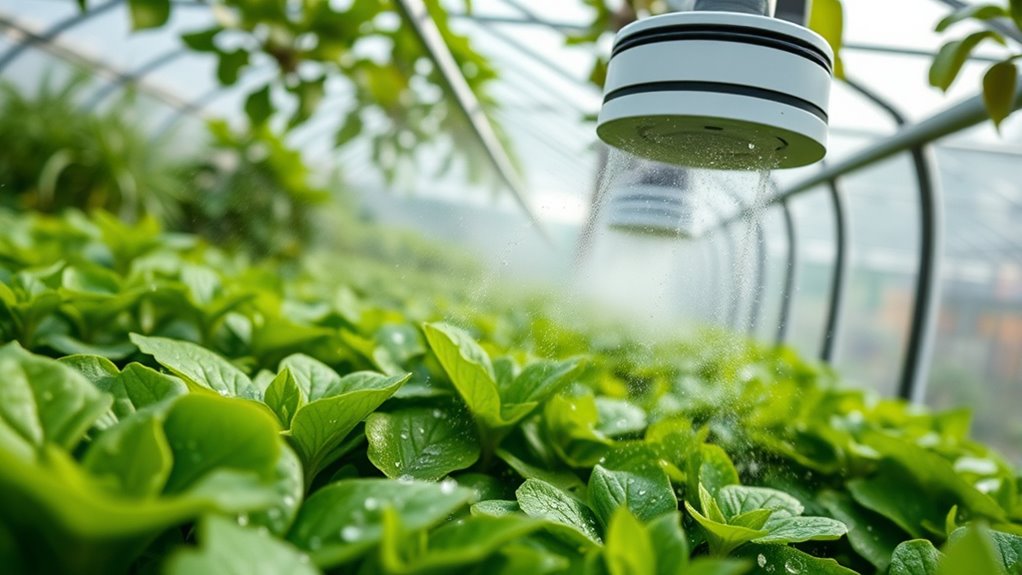
Maintaining proper humidity levels and ensuring good ventilation are essential for healthy plant growth. You should regularly monitor humidity control to prevent excessive moisture that promotes fungal diseases. Use a hygrometer to keep humidity within ideal ranges, typically around 50-60%, depending on your plants. Good airflow management is equally important; it helps reduce stagnation and dries excess moisture on plant surfaces. Ventilate your growing area by opening windows or using fans to promote consistent air movement. Proper ventilation prevents humidity from rising too high and reduces the risk of fungal pathogens taking hold. Additionally, using vetted home theatre projectors can help you observe and monitor your environment more effectively, ensuring optimal conditions. By actively managing humidity and airflow, you create an environment less conducive to disease development, supporting healthier, more resilient plants.
Adjust Watering Based on Weather Conditions
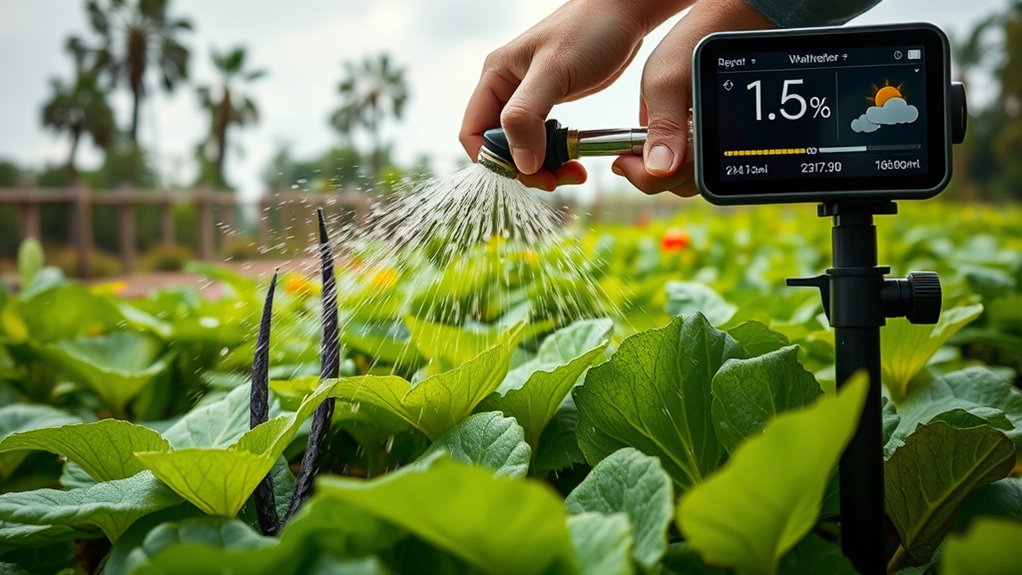
Since weather conditions can vary considerably, adjusting your watering schedule is essential for healthy plant growth. Proper weather adaptation helps prevent overwatering and reduces fungal disease risk. Pay attention to rainfall response; if it’s rainy, skip watering to avoid excess moisture. During dry spells, increase watering slightly to compensate. Additionally, understanding signs of spoilage in your watering practices can help prevent root rot and other fungal issues.
Frequently Asked Questions
How Can I Tell if My Plants Are Receiving Too Much or Too Little Water?
You can tell if your plants get too much or too little water by checking soil moisture regularly. If the soil feels soggy or stays wet for days, you’re overwatering and should reduce watering frequency. On the other hand, if the soil feels dry several inches down, your plants may need more water. Adjust your watering schedule accordingly to keep the soil moist but not waterlogged, supporting healthy growth.
What Signs Indicate Fungal Disease Due to Improper Watering?
You notice strange leaf spots or mold growth on your plants, and suddenly, you’re on alert. These signs often hint at fungal disease caused by improper watering. Excess moisture creates the perfect environment for fungi to thrive, leading to these telltale symptoms. If left unchecked, the disease can spread rapidly, threatening your plant’s health. Keep a close eye on these signs and adjust your watering habits to prevent fungal outbreaks.
Are There Specific Plant Types That Require Different Watering Practices?
Different plant types need specific watering practices to stay healthy. You should focus on plant-specific watering, adjusting your approach based on their unique needs. For example, some plants prefer shallow watering, while others thrive with deep root zone moisture. By understanding each plant’s requirements, you can avoid overwatering or underwatering, which helps prevent fungal issues and supports robust growth. Always consider the plant’s natural habitat when adjusting your watering routine.
How Do Watering Practices Differ for Container Plants Versus In-Ground Plants?
Think of your garden as a battlefield; your watering practices are your secret weapon. For container plants, use drip irrigation to deliver direct, consistent moisture and apply mulch techniques to prevent fungal spores from settling. In-ground plants benefit from deep, infrequent watering, also with mulch to keep soil dry and discourage disease. Adjust your approach based on plant type, ensuring each gets the right moisture level for healthy growth.
Can Watering Habits Influence Other Pests Besides Fungal Diseases?
Your watering habits can definitely influence pest attraction beyond fungal diseases. If you water too frequently or keep plants overly moist, you create an inviting environment for pests like aphids, slugs, and spider mites. Adjust your watering frequency to avoid excess moisture, which helps reduce pest problems. Proper watering not only keeps your plants healthy but also minimizes conditions that pests find attractive, giving you a better shot at pest control.
Conclusion
By adopting these watering practices, you can substantially reduce fungal disease risks in your garden. Did you know that overwatering is a leading cause of fungal problems, with studies showing it accounts for nearly 60% of plant infections? Water early, use drip systems, and keep soil well-drained to keep your plants healthy. With consistent adjustments based on weather, you’ll promote stronger growth and enjoy a more vibrant, disease-free garden.
